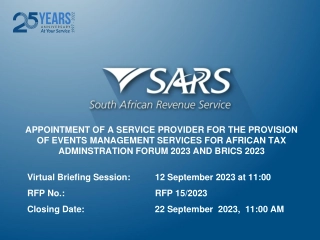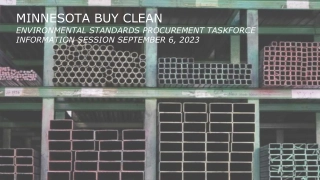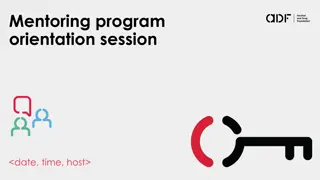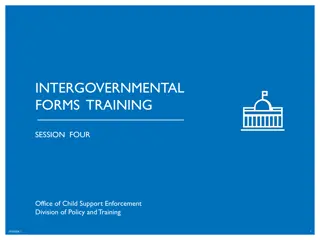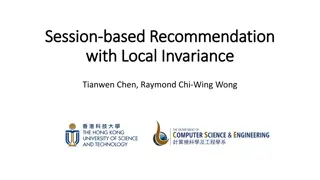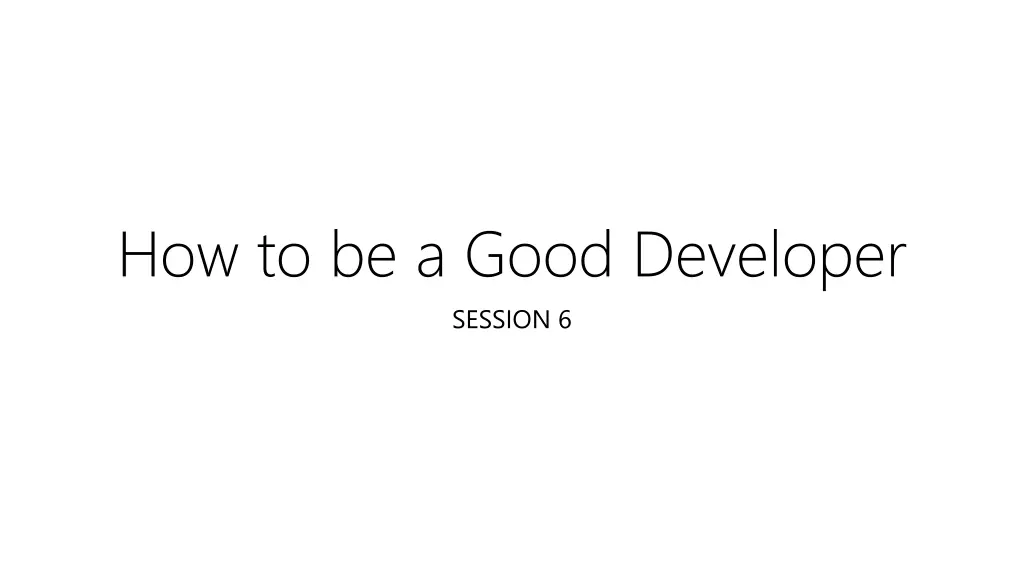
Developer Best Practices & Patterns
Discover key values, principles, and design patterns essential for becoming a successful developer. Learn about simplicity, communication, feedback, courage, respect, Boy Scout Rule, persistence, and more. Explore various creational, structural, and behavioral design patterns like Factory Method, Singleton, Decorator, and Command. Dive into principles such as Don't Repeat Yourself and Inversion of Control for efficient coding practices.
Uploaded on | 0 Views
Download Presentation

Please find below an Image/Link to download the presentation.
The content on the website is provided AS IS for your information and personal use only. It may not be sold, licensed, or shared on other websites without obtaining consent from the author. If you encounter any issues during the download, it is possible that the publisher has removed the file from their server.
You are allowed to download the files provided on this website for personal or commercial use, subject to the condition that they are used lawfully. All files are the property of their respective owners.
The content on the website is provided AS IS for your information and personal use only. It may not be sold, licensed, or shared on other websites without obtaining consent from the author.
E N D
Presentation Transcript
How to be a Good Developer SESSION 6
Values Simplicity Communication Feedback Courage Respect 2
Principles Boy Scout Rule Persistence Ignorance You Aren t Gonna Need It Keep It Simple Stable Dependencies Hollywood Single Responsibility Open-Closed Liskov Substitution Interface Segregation Don t Repeat Yourself Inversion of Control Dependency Inversion Explicit Dependencies Once and Only Once Separation of Concerns Tell, Don t Ask Encapsulation Principle of Least Surprise 3
Patterns | Creational, Structural, Behavioural Factory method Abstract factory Builder Prototype Singleton Adaptor Bridge Composite Decorator Facade Flyweight Proxy Chain of responsiblity Command Interpreter Iterator Mediator Memento Observer State Stategy Template Visitor 4
Principles | Dont Repeat Yourself This principle states to remove both repetition of process and repetition of logic. 5
Principles | Inversion of Control A principle in which custom-written portions of a computer program receive the flow of control from a generic framework. 7
Principles | Inversion of Control Traditional control main Method 1 Method 2 Method 3 Method 4 8
Principles | Inversion of Control Inverted control IoC Module 1 Module 2 Container Module 3 Module 4 9
Pattern | Proxy Structural This pattern is centred around creating a placeholder for another object to control access to it. There are 4 common situations where it s applicable 10
Pattern | Proxy Structural 1. A virtual proxy for expensive to create objects. The real object is created first accessed 2. A remote proxy to provide a local instance for an object that is in a different address space 3. A protective proxy controls access to a private object. The proxy checks permissions of a caller before allowing access 4. A smart proxy adds additional actions on access like reference counting, loading or synchronisation. 11
Pattern | Proxy Structural Accessor Far Away Resource uses Resource Class A 12
Pattern | Proxy Structural Accessor Far Away Proxy Far Away Resource uses cached access Proxy Resource Class A 13
public interface Image { void display(); } public class ProxyPatternDemo { public static void main(String[] args) { Image image = new ProxyImage("test_10mb.jpg"); public class RealImage implements Image { //image will be loaded from disk image.display(); System.out.println(""); //image will not be loaded from disk image.display(); } } private String fileName; public RealImage(String fileName){ this.fileName = fileName; loadFromDisk(fileName); } @Override public void display() { System.out.println("Displaying " + fileName); } private void loadFromDisk(String fileName){ System.out.println("Loading " + fileName); } } 14
Pattern | Proxy Creational Source Making : Proxy Design Pattern https://sourcemaking.com/design_patterns/proxy Wikipedia: Proxy Pattern https://en.wikipedia.org/wiki/proxy_pattern 15
the behavioural design patterns behavioural design patterns identify common communication patterns between a client and code, and try to remain loosely coupled whilst enabling this communication 16
Pattern | Chain of Responsibility Behavioural This pattern is concerned with the scenario of a client having a request which can be dealt with by multiple receivers. As a way of avoiding coupling, it recommends chaining handlers so that the request can be passed from one to the next until a handler accepts and deals with the request. The number of handlers isn t known beforehand and they can be configured dynamically. 17
Pattern | Chain of Responsibility Behavioural 18
[Flags] public enum LogLevel { None = 0, // 0 Info = 1, // 1 Debug = 2, // 10 Warning = 4, // 100 Error = 8, // 1000 FunctionalMessage = 16, // 10000 FunctionalError = 32, // 100000 All = 63 // 111111 } 19
/// <summary> /// Abstract Handler in chain of responsibility pattern. /// </summary> public abstract class Logger { protected LogLevel logMask; // The next Handler in the chain protected Logger next; public Logger(LogLevel mask) { this.logMask = mask; } /// <summary> /// Sets the Next logger to make a list/chain of Handlers. /// </summary> public Logger SetNext(Logger nextlogger) { next = nextlogger; return nextlogger; } public void Message(string msg, LogLevel severity) { if ((severity & logMask) != 0) //True only if all logMask bits are set in severity { WriteMessage(msg); } if (next != null) { next.Message(msg, severity); } } abstract protected void WriteMessage(string msg); } 20
public class ConsoleLogger : Logger { public ConsoleLogger(LogLevel mask) : base(mask) { } protected override void WriteMessage(string msg) { Console.WriteLine("Writing to console: " + msg); } } public class EmailLogger : Logger { public EmailLogger(LogLevel mask) : base(mask) { } protected override void WriteMessage(string msg) { // Placeholder for mail send logic, usually the email configurations are saved in config file. Console.WriteLine("Sending via email: " + msg); } } 21
public class ConsoleLogger : Logger { public ConsoleLogger(LogLevel mask) : base(mask) { } protected override void WriteMessage(string msg) { Console.WriteLine("Writing to console: " + msg); } } public class EmailLogger : Logger { public EmailLogger(LogLevel mask) : base(mask) { } protected override void WriteMessage(string msg) { // Placeholder for mail send logic, usually the email configurations are saved in config file. Console.WriteLine("Sending via email: " + msg); } } 22
class FileLogger : Logger { public FileLogger(LogLevel mask) : base(mask) { } protected override void WriteMessage(string msg) { // Placeholder for File writing logic Console.WriteLine("Writing to Log File: " + msg); } } 23
public class Program { public static void Main(string[] args) { // Build the chain of responsibility Logger logger, logger1, logger2; logger = new ConsoleLogger(LogLevel.All); logger1 = logger.SetNext(new EmailLogger(LogLevel.FunctionalMessage | LogLevel.FunctionalError)); logger2 = logger1.SetNext(new FileLogger(LogLevel.Warning | LogLevel.Error)); // Handled by ConsoleLogger since the console has a loglevel of all logger.Message("Entering function ProcessOrder().", LogLevel.Debug); logger.Message("Order record retrieved.", LogLevel.Info); // Handled by ConsoleLogger and FileLogger since filelogger implements Warning & Error logger.Message("Customer Address details missing in Branch DataBase.", LogLevel.Warning); logger.Message("Customer Address details missing in Organization DataBase.", LogLevel.Error); // Handled by ConsoleLogger and EmailLogger as it implements functional error logger.Message("Unable to Process Order ORD1 Dated D1 For Customer C1.", LogLevel.FunctionalError); // Handled by ConsoleLogger and EmailLogger logger.Message("Order Dispatched.", LogLevel.FunctionalMessage); } } } 24
Pattern | Chain of Responsibility Structural Source Making : Chain of Responsibility Design Pattern https://sourcemaking.com/design_patterns/chain_of_responsibility Wikipedia: Chain of Responsibility Pattern https://en.wikipedia.org/wiki/chain-of-responsibility_pattern 25
Next session Principles | Dependency Inversion Principles | Explicit Dependencies Patterns | Command Patterns | Interpreter 26


